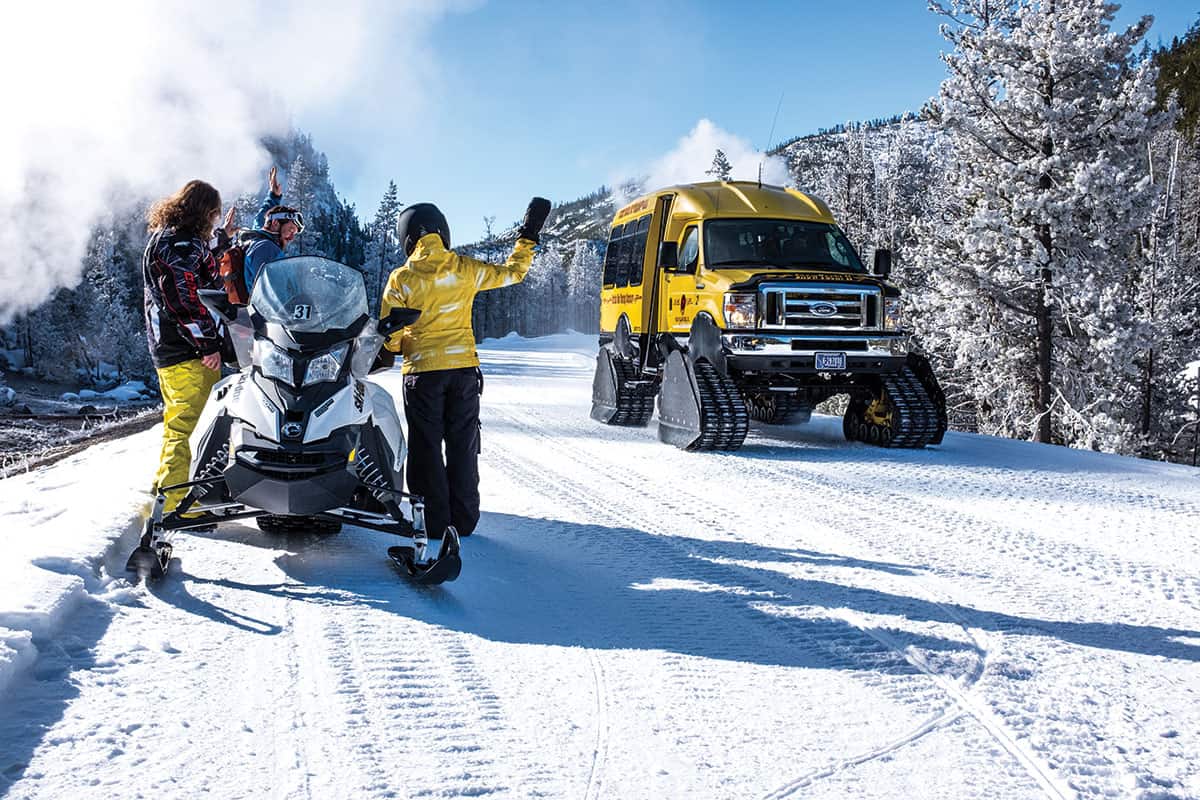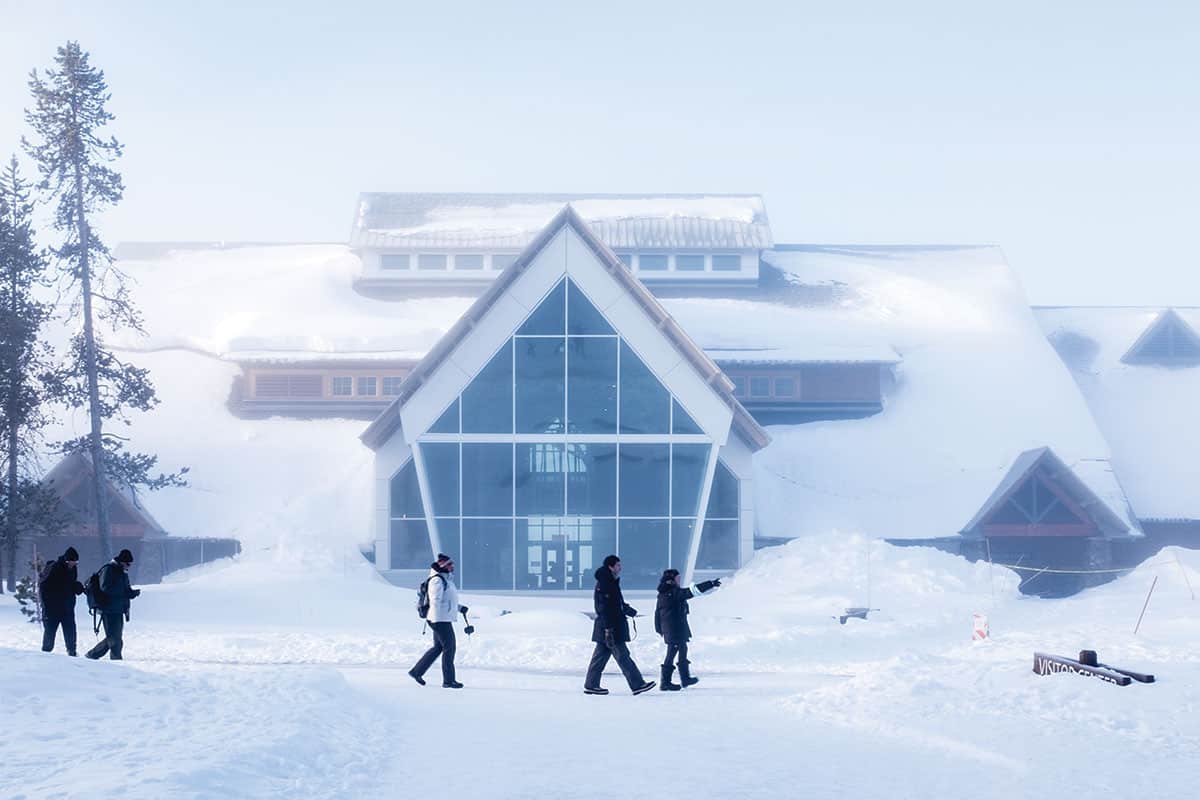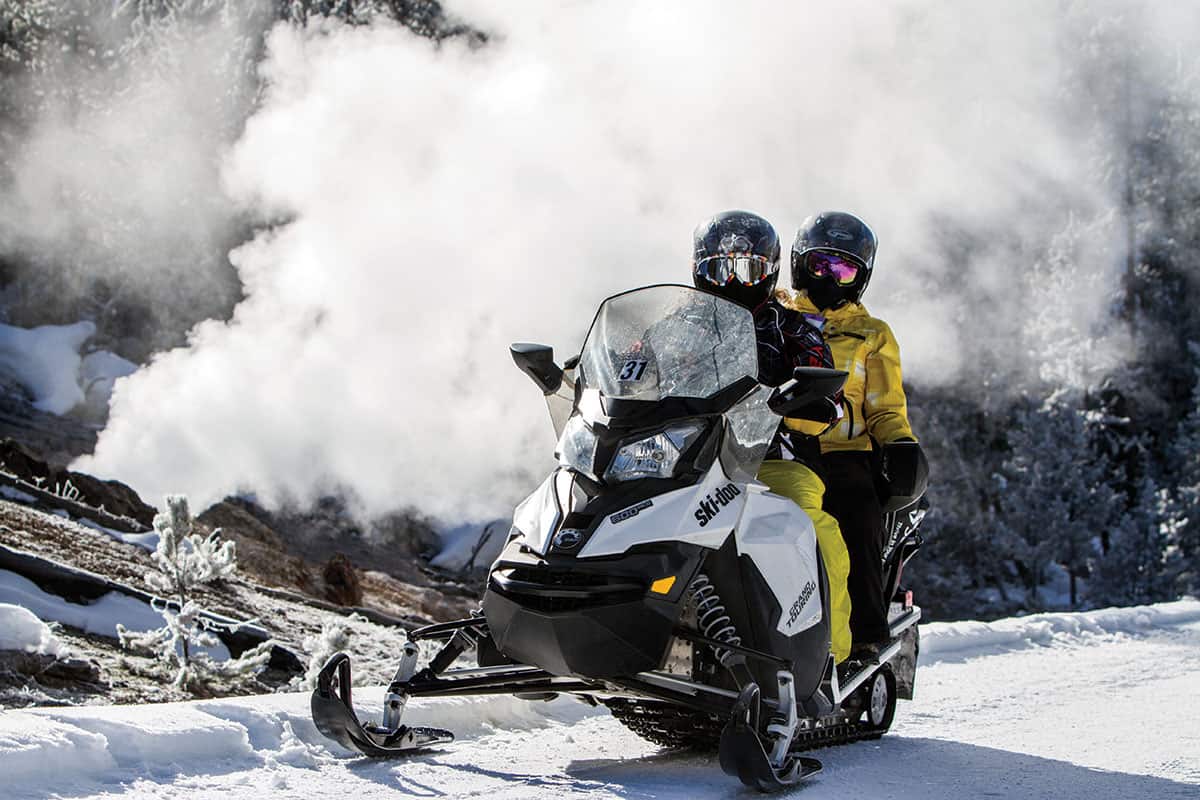Read The
Current Issue
DIY Yellowstone
With a permit, you can snowmobile into Yellowstone without a guide.
By Mike koshmrl • Photography by ryan jones

IN ALL THE times I had driven by Lewis Falls, between Canyon Village and Yellowstone’s South Gate, I’m ashamed to say I’d never stopped to admire it. But now, even though temperatures are well below freezing and the road is buried beneath so much snow the only way to travel is via snowmobile (or snowcoach, skis, or snowshoes), I finally feel the impulse. Our group—all on snowmobiles—stops at a pullover near the falls. We dismount our sleds and crunch through snow to the best vantage point. It turns out Lewis Falls is impressive. But more impressive is that nothing but silence competes with the sounds of water rushing thirty feet over the falls.
There is no chatter from dozens of other visitors. There are no vehicles, snowmobile or otherwise, whizzing by. There is no yelling to “bring the camera!” or “hurry!” It’s just water pushing around and over rocks until it crashes into a frothy pool at the bottom. In the sounds of the falls I imagine I hear, “Welcome to winter in Yellowstone.”
In wintertime, Yellowstone National Park is transformed. Its transformation isn’t just from the thirteen feet of snow it gets annually, but also because this snow—and the road, hotel, restaurant, and visitor center closures it causes—impacts the number of park visitors. More than 4 million people visit the park each summer. Between mid-December and mid-March, Yellowstone’s winter season, it gets only about 100,000 visitors. Snow-covered, Yellowstone is a seldom-seen world. The fact that we’re here on our own—our group of four is without a guide, even—makes the park that much more our own private playground. Our group has two days to explore as much of it as we can.
IT WAS ONLY three winters ago that planning a private, unguided overnight trip into Yellowstone (like my three friends and I have done) became possible for visitors who weren’t the most intrepid of adventurers. Between 2004 and 2014, it was illegal to snowmobile into Yellow-stone on your own. The options were a guided snowmobile or snowcoach trip, or, if you didn’t want a guide, human-powered means like snowshoes or skis. Since the only services and lodging (at Old Faithful) are forty-two miles from the end of the plowed road at Yellowstone’s South Gate (only thirty miles if you start at the West Gate) snowshoers and skiers had better be in superhero shape or planning to camp. Also, they can’t afford for anything to go wrong because cell service in the park is nil.
So the return of legal nonguided travel in Yellowstone is enabling: Hundreds of people who would otherwise not be able to experience the park in winter can again do so, their legs straddling a snowmobile. It is in the guise of my job as the environmental reporter for the Jackson Hole News&Guide (the newspaper secured a leftover “noncommercially guided” permit, required for snowmobile adventures) that we are able to snowmobile in sans guide.
Heading north from Flagg Ranch, the solitude is striking and colors the whole experience: Without a doubt, it’s the lack of anyone around that triggers my urge to pull over at Lewis Falls. Save for a single guided group peering through the windows of a snowcoach, we see no one for over an hour on the ride in. And until early afternoon, when we approach Old Faithful, we pass no snowmobilers or snowcoaches with any regularity. Yellowstone, impossibly, feels like it is all ours.
There’s plenty of space to get the hang of driving our Ski-Doo Grand Touring Sport 600s. Snowmobiling turns out to be simple, especially because snowmobiling in Yellowstone is restricted to groomed trails and parking lots, and there’s a park-wide 35 mph speed limit. My friends and I have only been on snow machines a few times. Still, accelerating, braking, and staying on the wide, groomed road surface are intuitive.
IN THE LATE afternoon, as the skies dim (winter days in Yellowstone are short), an adequate command of my snowmobile, specifically knowing how to go backwards, comes in handy. As we head for our cabins at Old Faithful, an ornery cow bison blocks the entrance road. My attempt to pass her, which requires me to get unnervingly close, results only in an annoyed look and lowered head (from her), and for me, a heightened heart rate. Since she shows no signs of moving—and a warm bed, cold beer, and dinner sound good—I employ the reverse button. We find a seldom-used alternative entrance to the Frontier Cabins at Old Faithful, which are just behind the Old Faithful Snow Lodge. Together, they make up the park’s lone interior winter lodging options.
The next morning, we squeeze in an Old Faithful viewing before tackling the 140(ish)-mile route we’ve planned. It’s a long day of riding, but we prefer that option to merely retracing what we rode yesterday. Instead of heading directly back to the South Gate from Old Faithful, we opt to go north toward Madison, then to Norris, Canyon, Fishing Bridge, and West Thumb on the inner park road before arriving back at our cars at the park’s South Gate.
It starts off with the trip’s first bone-chilling cold, courtesy of a frigid fog socking in the Firehole River Valley. Likely caused by hot water wisping off the valley’s thermal pools and geysers in the bitter morning air, the fog freezes onto our helmet shields, which makes visibility tough. We have to keep the plastic shields down, though; at 35 mph, any exposed skin gets very cold very quickly. South of Madison Junction, we finally punch through the fog and into sunshine. The sun doesn’t disappear for the rest of the ride.
As the miles tick by, I yearn to explore off the trail, or at least move my legs more than the length of a boardwalk. But without the equipment to do so—cross-country skis or snowshoes—it’s a tough itch to scratch. The day before, trying to walk up to a ridge above Grand Prismatic Spring, we quickly sank in the snow, first to our thighs, then our waists. We realized quickly it could take hours to gain the ridge and eventually gave up. Maybe the ultimate way to explore Yellowstone in winter is a combination of new and old—snowmobile in, and then use skis or snowshoes for side trips. A walk to inspect a distant bison carcass in the Hayden Valley and a ski to the Lone Star Geyser are on my short list of side trips. Next time.



Nuts & Bolts
Daily during the park’s winter season, one permit (for a group of up to five snowmobiles) is available from each of Yellowstone’s four main entrances, at the west, the south, the east, and the north. Permits are distributed via a lottery that accepts applications from September 1 until September 30. Leftover permits (like the one I got) are available first-come, first-served startinag November 3 (and also throughout the winter, as trips get canceled). Entering the lottery is $6, and, if awarded a permit, it’s an additional $40 permit cost plus a $25-per-snowmobile entrance fee. Visit recreation.gov for information. Best available technology sleds can be found at Leisure Sports, at 1075 US-89. Book a winter stay at Old Faithful at yellowstonenationalparklodges.com.




